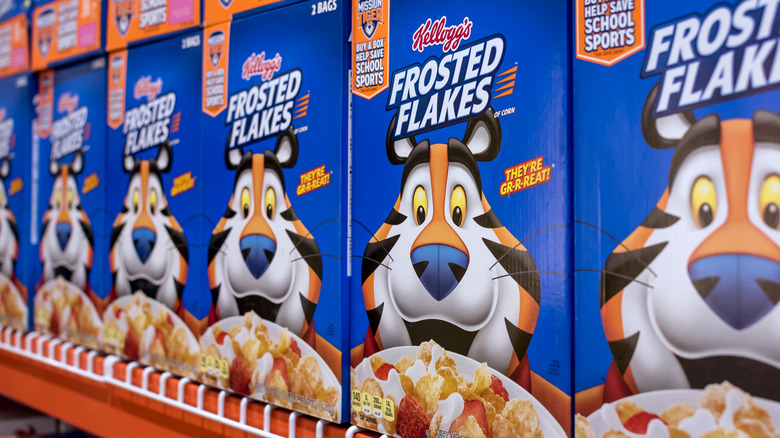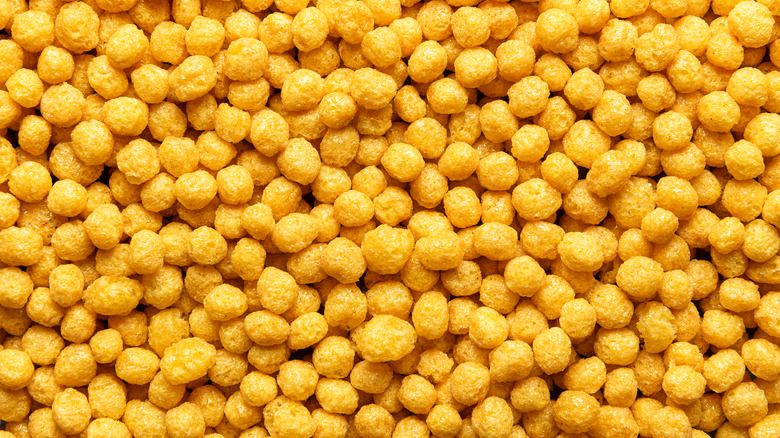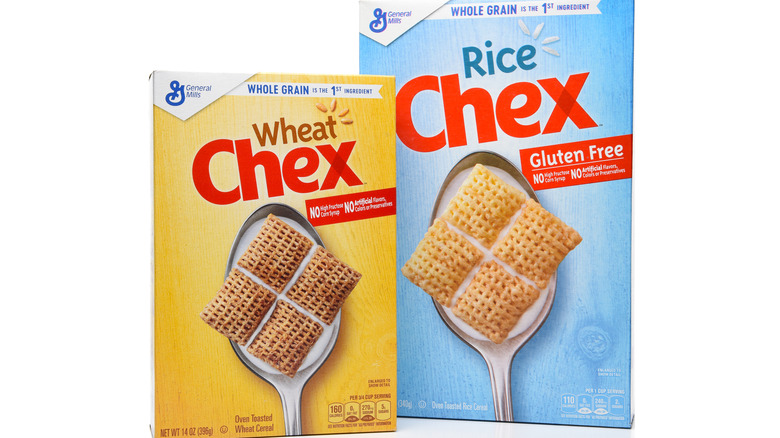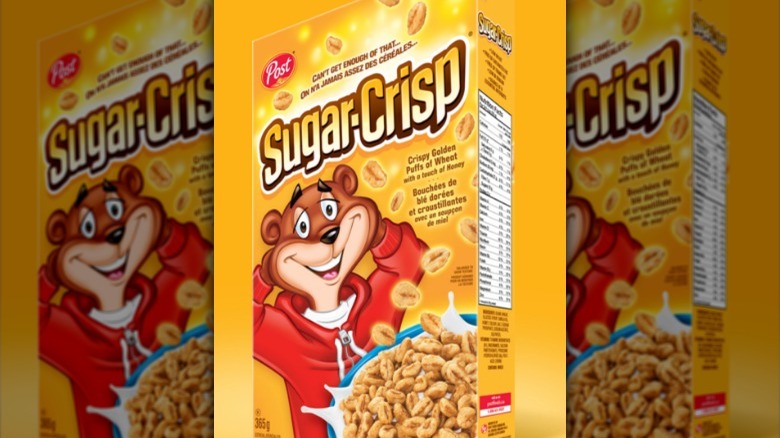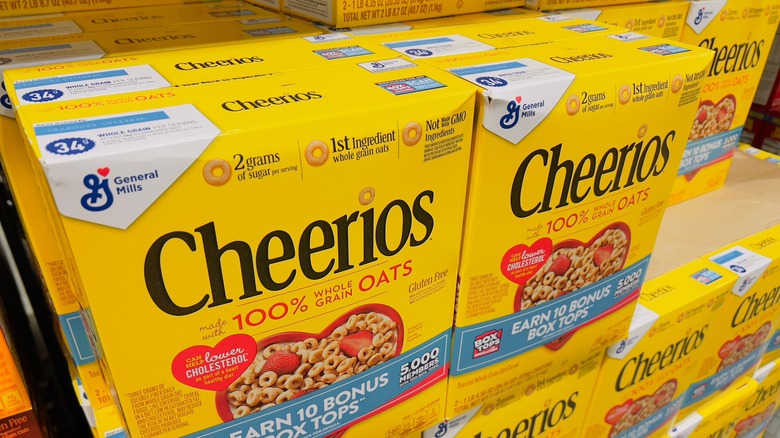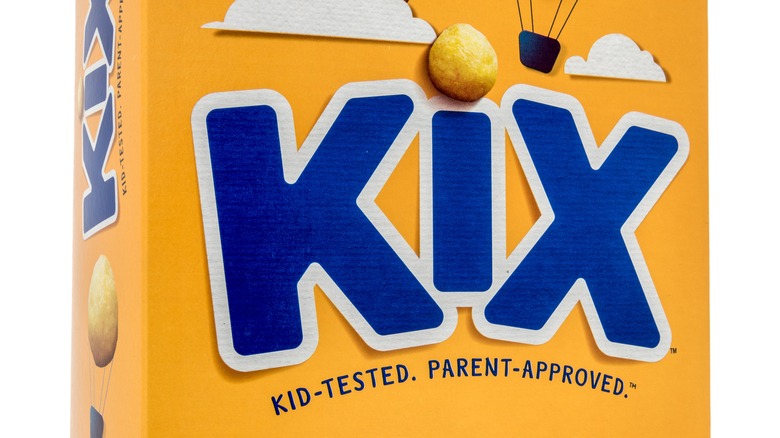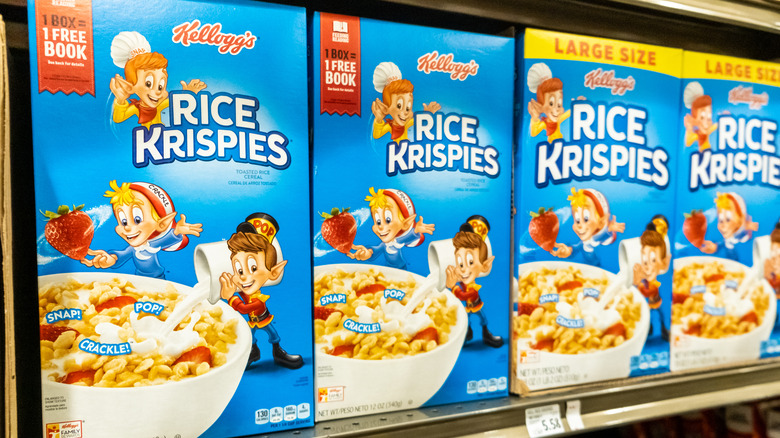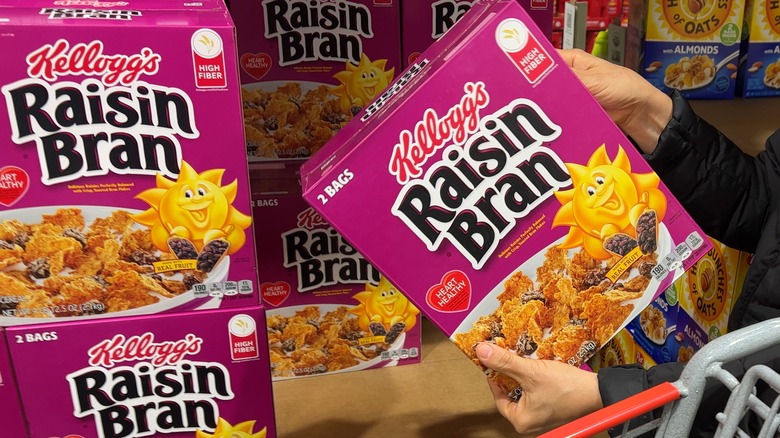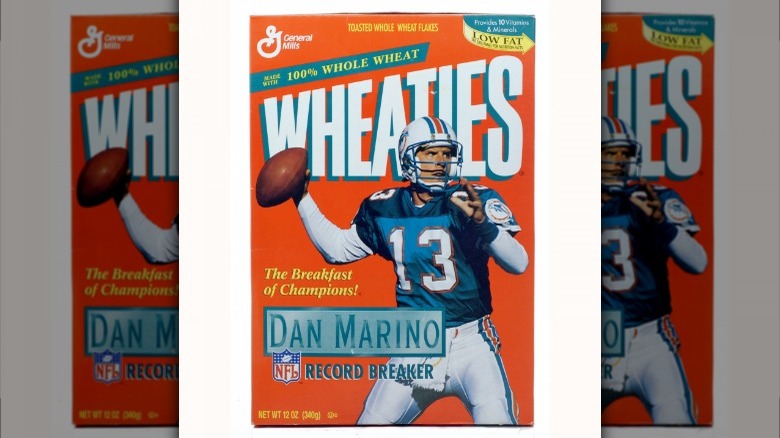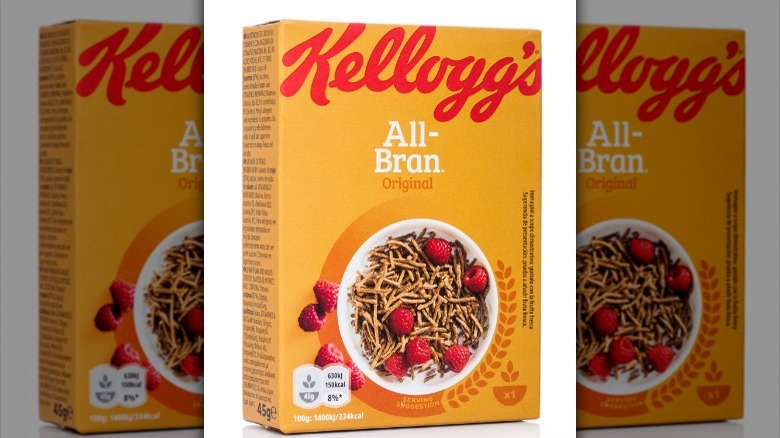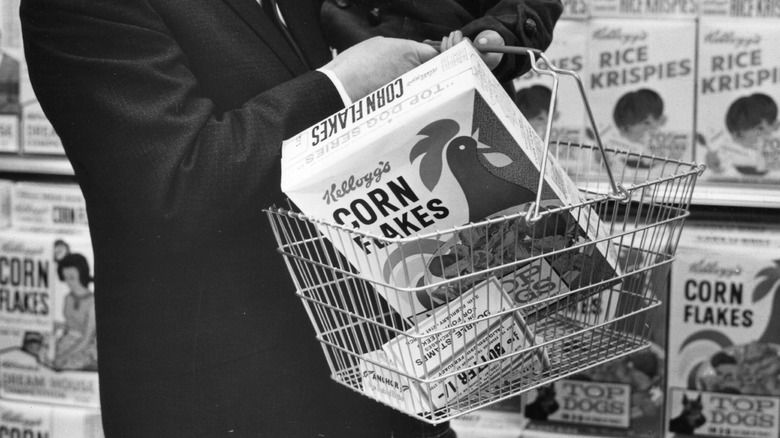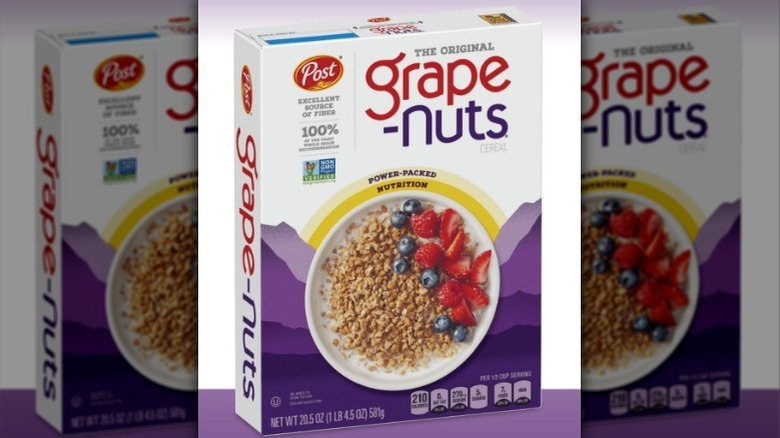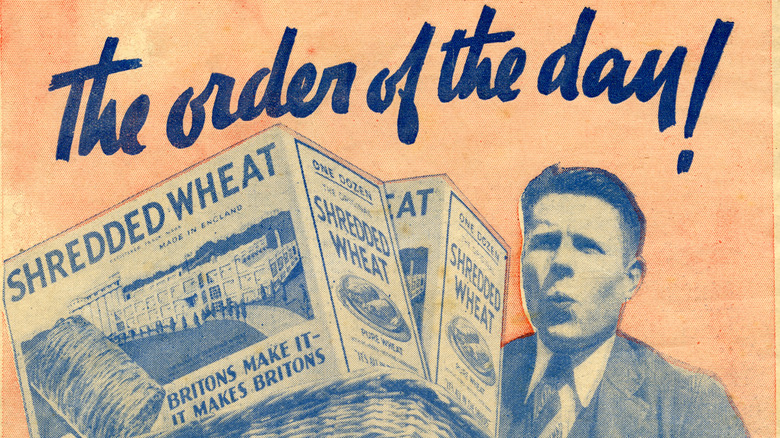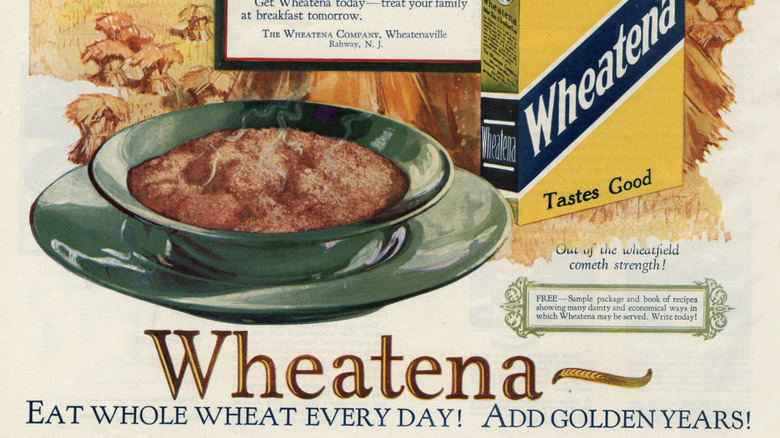14 Of The Oldest Cereals Still On Shelves
For generations, cereal has been how Americans start the day. In 2020 alone, more than 280 million Americans ate cereal at least once (via Statista). It's no surprise there are some old cereals on store shelves — at least in terms of when they were created. We're not talking about stale cereal.
New cereals are frequently hitting the shelves, but some have been around for decades. There's a good chance that not only did your parents enjoy a few bowls of your favorite cereal, but so did your grandparents — and maybe even your great-grandparents.
Today, we're looking at 14 of the oldest cereals still produced in the U.S. The first cold breakfast cereal dates to 1863 when James Caleb Jackson created Granula, a predecessor to modern granola (via Smithsonian Magazine). The Dansville Public Library recounts that Granula was originally a treatment for patients at the Dansville Water Cure Sanitarium, and while it's no longer around there are plenty of other cereals from the 1900s and earlier. We have everything you need to know about these classic cereals along with some interesting, even strange facts. Let's raise a spoon to the oldest breakfast cereals that have stood the test of time.
1. Frosted Flakes, 1952
Since 1952, kids and adults have been enjoying Kellogg's Frosted Flakes (via Kellogg's). Launched a year after the first frosted corn flake cereal — Post's Corn-Fetti — Frosted Flakes have long outlasted the version from their rival cereal maker. In 2020, an estimated 8.52 million Americans consumed 10 bowls or more per week of the sugary flakes (via Statista).
Interestingly, when first introduced by Kellogg's, the cereal was known as Sugar Frosted Flakes (via Mr Breakfast). However, around 1984, the word "sugar" was dropped from the name. It was one of several cereals to lose the word sugar during the 1980s.
Frosted Flakes was also one of the oldest cereals to be introduced with a cartoon character mascot. Tony the Tiger helped pave the way for the Trix Rabbit, Lucky the Leprechaun, and others. But did you know the mascot was almost a kangaroo? Kellogg's explains that there were several mascots in contention, including Tony the Tiger and Katy the Kangaroo. Executives couldn't decide which they wanted, so Kellogg's initially offered Frosted Flakes boxes featuring each mascot. The boxes with Tony the Tiger sold better, cementing his place in cereal history (via Mr Breakfast).
2. Corn Pops, 1950
Corn Pops have a trivia-worthy place in cereal history. They were the first new cereal introduced by Kellogg's following World War II — and one of the company's earliest forays into pre-sweetened cereal (via Just-food.com). Mr Breakfast reports the cereal officially debuted in 1950, but Corn Pops soared the following year when they became the sponsor of "The Adventures of Wild Bill Hickok" radio and television show. The characters pitched Corn Pops at the start of each broadcast and appeared in separate Corn Pops TV commercials.
It's commonly believed that Corn Pops also has the unofficial record for the cereal with the most name changes. They were initially introduced in 1950 as Corn Pops, but Kellogg's shortly changed the name to Sugar Corn Pops, and then just Sugar Pops. In the 1970s, the name reverted to Sugar Corn Pops, and they soon became Corn Pops again. Then in January 2006, Kellogg's shortened the name to just Pops, but the new name was received poorly, so they went back to Corn Pops a few months later (via The Big Book of Health and Fitness). Either way, Statista reports that plenty of people still gotta have their Pops, with more than 2 million Americans eating 10 or more bowls a week in 2020.
3. Chex, 1950/1936
Chex is one of the most recognizable cereals in America, in part because of the Chex Mix party snack introduced in the 1950s (via Foodtimeline.org). But the cereal's lineage has a decidedly non-party edge. Chex was originally a product of the Purina Food Company, which was founded in 1896 by William Henry Danforth (via Soy Info Center). He was also a follower of Ralstonism, an 1890s health and social movement created by Webster Edgerly (via Hopewell Express). Ralstonism, among other things, promoted eugenics and claimed its members would be able to control the minds of others, as Archeology explains.
According to the Soy Info Center, in 1897, Edgerly agreed to let Danforth produce a whole grain cereal for Ralstonism followers. Purina Food Company was making "Ralston Health Club Breakfast Food" by June of that year, with the less-wordy Ralston Wheat introduced in 1898 (via Mr Breakfast). The company's name was then officially changed to Ralston Purina in 1902, cementing the connection (via Purina).
While the social movement died out, the food company lived on. In 1936, Ralston Purina launched Shredded Ralston, which is considered an early version of Wheat Chex (via Mr Breakfast). They began using the Chex name in 1950 for Rice Chex, and shortly afterward the company changed Shredded Ralston's name to Wheat Chex. The final tie to the cereal's dubious past was finally severed when, as reported in the Wall Street Journal, General Mills purchased the Chex brand name in 1997 — except for in South Korea and Singapore, where Kellogg's owns the Chex rights.
4. Golden Crisp/Sugar Crisp, 1948
While not the oldest pre-sweetened cereal — that ubiquitous honor goes to Ranger Joe Wheat Honnies, which were introduced in 1939 — Golden Crisp was the first one to become a national phenomenon (via "Candy").
This Post cereal was actually inspired by Cracker Jack popcorn and originally known as Happy Jax before the name changed to Sugar Crisp in 1949 (via "Candy"). Like Corn Pops, the cereal went through several more name changes. It became Super Sugar Crisp in 1967, Super Golden Crisp in 1985 in response to the anti-sugar movement (as explained in "Salt Sugar Fat"), and finally just Golden Crisp — except in Canada, where the cereal is still known as Sugar Crisp to this day.
One thing that hasn't changed over the years is the high sugar level. When Golden Crisp first hit the shelves, it had a remarkable 51% sugar content — more than half (via "The Oxford Companion to Sugar and Sweets"). A 2008 Consumer Reports study found that Golden Crisp still exceeded the 50% mark. No wonder their mascot Sugar Bear can't get enough of that Golden Crisp.
As a final aside, if you've ever noticed a similarity between Post Golden Crisp and Kellogg's Honey Smacks, that's not a coincidence. Mr Breakfast notes that Honey Smacks (then Sugar Smacks) were intended to directly compete, and the two are almost identical in composition.
5. Cheerios, 1941
Cheerios is one of the world's most-recognizable cereal brands, and in a 2020 report Cheerios was named the ninth-most trusted brand by consumers. But like many of the old cereals on this list, it originally went by a different name.
When introduced in 1941, the cereal was known as Cheerioats. However, Quaker objected to General Mills' use of oats on the grounds that they held exclusive rights to use the word commercially for oatmeal — or at least, they claimed to. Rather than put up a fight, General Mills changed the name to Cheerios (via "The Advertising Age Encyclopedia of Advertising"). The rest, as they say, is history.
General Mills purportedly experimented with more than 500 formulas — as well as 10-plus shapes and sizes — before choosing the combination we now know as Cheerios (via General Mills). All the work clearly paid off. According to Kiplinger, as recently as 2018 Cheerios was the best-selling cereal in the U.S., with Honey Nut Cheerios ranking second. Other varieties include Multi Grain Cheerios, Frosted Cheerios, Apple Cinnamon Cheerios, and Chocolate Cheerios, giving kids and adults plenty of ways to enjoy their O's.
6. Kix, 1937
Introduced during the Great Depression, Kix was only the second cereal ever produced by General Mills according to Mr Breakfast. (The first one, Wheaties, is also still around today.) More importantly, it was one of the first cereals made of puffed corn. The puffing gun was patented by Alexander Anderson in 1902, and Quaker had been using it for years to make Puffed Wheat and Puffed Rice, advertising them as "blasted by steam explosion," among other things (via The Ladies' Home Journal).
However, by the 1930s, the patent had expired. Thomas James, an engineer at General Mills, took the technology and developed a version for puffing corn into a pellet shape (via General Mills). Combined with a cereal formula the company had been working on, General Mills rolled out Kix in 1937 (via General Mills). It quickly took off — thanks in part to its sponsorship of "The Lone Ranger" radio show — and it's still "Kid-Tested, Mother-Approved" to this day (via The Advertising Age Encyclopedia of Advertising). Not only that, but the technology has been used to create many other popular General Mills cereals, including Cheerios, Cocoa Puffs, Trix, and Lucky Charms.
7. Rice Krispies, 1928
Rice Krispies was developed by Kellogg's in 1927 and released to the public the following year. According to company lore, the R&D team presented the puffed rice grains to company founder W.K. Kellogg, who responded, "You've got something here!" (via Kellogg's).
The cereal is known as much for the distinct sound it makes in milk as it is for the taste itself. Kellogg's realized this right away and initially marketed Rice Krispies as "The Talking Cereal" before first introducing the now famous "Snap! Crackle! Pop!" slogan in 1932. According to LiveScience and food scientist Ted Labuza, this sound is most likely caused by the cereal's physical structure, with pockets of air that are shattered by the pressure liquid puts on them.
Like Chex and Chex Mix, the popularity of Rice Krispies has been boosted over the years by the Rice Krispie Treat. Kellogg's test kitchen worker Mildred Ghrist Day is widely credited with inventing the snack in 1939, and the first test run was as a Camp Fire girl's fundraising project (via Iowa State University). According to Kellogg's, after the treat's success they began putting the recipe on the Rice Krispies cereal box in 1941.
8. Raisin Bran, 1926
Today, every major cereal company has a version of raisin bran — including Kellogg's Raisin Bran, Post Raisin Bran, and General Mills Raisin Nut Bran. However, the first raisin bran to hit shelves was from the Skinner Manufacturing Company. Skinner's Raisin Bran was introduced in 1925, and they trademarked the term "raisin bran" shortly thereafter (via Circuit Court of Appeals).
So why are there so many raisin brans today? Well, Skinner's trademark didn't stop other companies from trying to use the name anyway. In 1943, the company filed a cease-and-desist against both Kellogg's and Post for selling products called raisin bran — but Skinner was in for a surprise. On August 4, 1944, the U.S. Circuit Court of Appeals, Eighth Circuit ruled that the term "raisin bran" was simply a description of the ingredients. Therefore, it was too generic to be trademarked.
With that, the Skinner Manufacturing Company's trademark was revoked, and other companies were free to use the name. However, Skinner's Raisin-Bran is still around today. After changing hands several times, it appears the brand is currently owned by Three Sisters Cereal and Uncle Sam, and it's available at Safeway grocery stores and other locations.
9. Wheaties, 1924
The "Breakfast of Champions" was the result of a happy accident. In 1921, an employee for the Washburn-Crosby Company accidentally spilled a wheat gruel mixture on a hot stove, which then bubbled into crispy flakes. The new cereal was introduced in 1924 as Washburn's Gold Medal Whole Wheat Flakes. They quickly realized the name was too long, though, and an employee contest was held to rename it. Suggestions included Gold Medal Wheat Flakes and Nutties but Jane Bausman, an export manager's wife, submitted the winning name of Wheaties (via General Mills).
Then on June 20, 1928, The Washburn-Crosby Company merged and rebranded to create General Mills, making Wheaties the first of many General Mills cereals. It wasn't the only Wheaties first. General Mills claims their singing Wheaties ad on Christmas Eve 1926 was the world's first commercial radio jingle. Then in 1934, Wheaties began putting pictures of prominent athletes on the box. New York Yankees first baseman Lou Gehrig was the first living person featured with female aviator Elinor Smith being the second (via General Mills). As of 2021, 850 athletes have been featured on Wheaties boxes, with the number continuing to grow (via Smithsonian Magazine).
10. All-Bran, 1916
Wheaties is far from the oldest cereal made of wheat bran. After testing the waters with 40% Bran Flakes cereal, Mr Breakfast explains that Kellogg's took things one step further in 1916 with All-Bran — now known as All-Bran Original. To this day, All-Bran is one of the few cereals that lists wheat bran as the first ingredient. Kellogg's claims the 1915 version of Bran Flakes was the first high-fiber cereal, a tradition which All-Bran continues. Based on a 2,000-calorie diet, one serving of All-Bran provides a whopping 44% of an adult's daily recommended fiber intake (via Smart Label).
Since the beginning, All-Bran has been touted as a healthy breakfast option. A 1932 book called "A New Way of Living," published by The Kellogg Company of Canada, claimed All-Bran was the key to living a life "free of constipation." All-Bran was also a pioneer of celebrity spokespeople for cereal, as Joan Crawford appeared in All-Bran print ads in the 1930s. More recently, William Shatner did an extensive promotional campaign for All-Bran (via Campaign). As part of this, Kellogg's Bran Flakes and Sultana Bran were rebranded as All-Bran products. That's a lot of bran!
11. Corn Flakes, 1906/1894 (possibly 1898)
To say Kellogg's Corn Flakes have a complicated history is putting it mildly. For starters, the official Kellogg's company history says they were invented in 1898 — even though the U.S. patent office issued John Harvey Kellogg a patent for the process of making flaked cereals in 1896 (via Google Patents). There are also disputes about who was responsible for corn flakes. John Harvey Kellogg claimed full credit for their creation, saying the recipe came to him in a dream. His brother W.K. Kellogg alleged the duo contributed equally to their development. Some versions of the story even say John's wife Ella played a role (via "The Kelloggs").
What is generally agreed upon is this: corn flakes were originally conceived as a healthy and easily digestible breakfast for patients at the Battle Creek Sanitarium in Michigan — and not to stop people from masturbating (via Snopes). The flake shape came from accidentally leaving out a batch of dough overnight that cooled and became stale, which the brothers then sent through their granola rollers anyway (via History). Corn flakes became commercially available in 1906 and were the best-selling breakfast cereal for many years (via Kellogg's). However, their popularity has waned in recent years, placing only nineteenth in cereal sales for 2018 (via Kiplinger).
12. Grape-Nuts, 1897
If you thought the history of corn flakes was shrouded in controversy, wait until you hear about Grape-Nuts. In the early 1890s, following his second nervous breakdown in seven years, C.W. Post spent time as a patient at the Kellogg's Battle Creek Sanitarium (via Texas State Historical Association). While there he became quite interested in the Kellogg brother's experiments with granola cereal and other foods (via Soy Info Center).
Some people say that C.W. Post was inspired by the Kellogg's' recipes (via History). Others, including W.K. Kellogg, alleged Post flat-out stole their work (via "The Kelloggs"). Either way, after leaving the sanitarium in 1892, Post entered the breakfast food business. The first cereal he produced was Grape-Nuts, a baked wheat cereal rather than a grape or nut based one. Even the official Grape-Nuts website admits there are two stories of how the cereal got its name. Post supposedly created the nut-sized nuggets by running the baked sheets through a coffee grinder.
We should also mention that although Post left the sanitarium, he didn't leave Battle Creek. Postum Cereal Company, which is now Post Consumer Brands, was founded in Battle Creek in 1895 not far from the sanitarium (via Post Consumer Brands). Both Post and Kellogg's still have manufacturing plants in the city, continuing the bitter rivalry (via Battle Creek Welcome Center).
13. Shredded Wheat, 1890
This well-known cereal was first invented in 1890 by Henry Perky (via Encyclopedia of Kitchen History). According to "Chicago's 1893 World's Fair," shredded wheat biscuits debuted at the Chicago World's Fair in 1893, and the manufacturing process was patented in 1895. Interestingly, John Harvey Kellogg was an admirer of the production process — although his sanitarium patients said that eating shredded wheat was "like eating a whisk broom" (via "Cornflake Crusade"). Kellogg even had an opportunity to buy the patent. According to the Encyclopedia of Kitchen History, Kellogg simply chose not to purchase it. However, another version of the story claims that Kellogg initially made an offer, but Perky then backed out of negotiations after Kellogg became indecisive (via "The Kelloggs").
Several companies make shredded wheat cereal today — and like with raisin bran, you can thank the courts for that. Perky died in 1908, and when the patent for shredded wheat expired, W.K. Kellogg began making his own version, leading to repeated battles with the Natural Food Company. After Nabisco bought the company in 1928, they filed a lawsuit that reached the U.S. Supreme Court (via "The Kelloggs"). In 1938, the court ruled 7-2 in favor of Kellogg, declaring that the "shredded wheat" name and biscuit shape were both generic enough that they could not be trademarked. It was a landmark decision that has influenced trademark law ever since (via Intellectual Property Stories).
14. Wheatena, 1879
Wheatena — pronounced "Wee-tee-na" — is a wheat cereal that was created by New York City bakery owner George H. Hoyt all the way back in 1879. The basic process involved roasting whole wheat and then grinding it. Later that year, Hoyt began running newspaper ads for his new "Wheatena," helping to popularize the cereal locally (via Homestat Farm).
As Homestat Farm explains, after the Health Food Company purchased the bakery in 1885 and moved production to Akron, Ohio, Wheatena took off. By the 1920s, it was one of the country's best-selling cereals with advertising coast to coast (via Library of Congress). They also sponsored the "Popeye Radio Show" from 1935-37 — which included changing Popeye's famous theme song to replace spinach with Wheatena (via Homestat Farm).
The wave of pre-sweetened cereals beginning in the late 1940s helped cool Wheatena's star. The cereal has also gone through many ownership changes over the years, and it's now owned by Homestat Farm, but you can still enjoy a bowl of the original whole wheat breakfast cereal. Wheatena is found in select stores nationwide, and you can also purchase it online.

